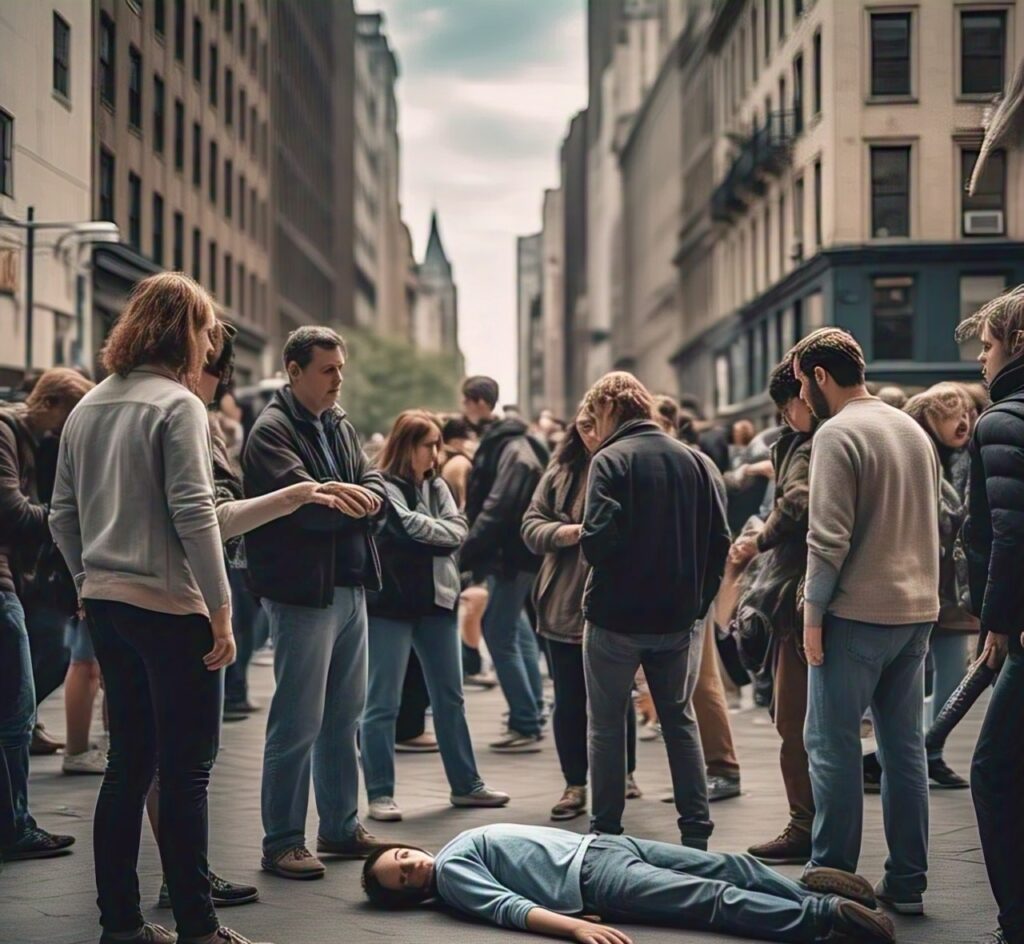Bystander effects can make someone hesitate to act or offer help, as they assume that others will do so or feel less responsible if others are present.
Imagine this: you’re walking along the street and hear someone calling for help. The victim is being attacked; what would you do? We would all like to believe that we would intervene or at least call 911. The truth is that this isn’t what always happens.
What is The Bystander Effect?
The bystander effect is the tendency of people to remain passive in situations involving serious danger due to other bystanders.
Bystander apathy is also known as the bystander effect. It refers to the phenomenon where the more people present, the less likely they are to assist someone in distress.
You would definitely help someone in need if you saw an emergency unfolding right in front of you, wouldn’t you? Psychologists suggest that while we may all want to believe this, the fact is that it could depend on how many witnesses are present.
The bystander effect can be defined as the phenomenon in which people in a group do not offer assistance to someone in an emergency situation, even though they are witnesses to the event.
How Psychology Explains The Bystander Effect
Darley and Latane conducted a series of experiments in which they found that people feel morally obligated to assist someone who is distressed if they think they are the only ones present. If they are surrounded by other people, they feel less compelled to help.
In 1969, Latane discovered that only 40% of people would assist a woman who is in distress when there were other people present.
According to a review, more recent studies have shown that people are less inclined to speak out if they see cyberbullying in large online forums.
Examples of The Bystander Effect
- Kitty Genovese Murder
Kitty Genovese, a young woman from Queens, New York, was brutally beaten and killed in 1964. Numerous neighbors heard Kitty’s cries but didn’t intervene or contact the police.
- Subway Confrontation
A passenger verbally harasses a fellow passenger on a crowded train. No one on the train says or does anything to address the situation.
- Fainting during a lecture
A student faints during a lecture, but everyone in the classroom assumes someone else will call for help or assist the student, resulting in a delay in medical attention.
- Car Accident
Some drivers will slow down after seeing a car crash, but they won’t stop to help or call 911. They assume that someone else will take care of the situation.
- Supermarket Fall
A senior citizen slips and falls at a supermarket. Shoppers nearby hesitate to help, thinking the store employees will handle the situation.
- Online Harassment
A member of an online forum is harassed and bullied by other members. Many users are aware of the harassment but don’t report it or take action because they assume that others will.
- Street Fight
On a busy street, two individuals engage in a physical altercation. The passersby walk on, not getting involved, thinking that someone else would handle the situation.
- Harassment in the workplace
An employee may be subjected, at work, to bullying or other forms of discrimination. The co-workers see the behavior but don’t report it to the HR department because they assume someone else will bring up the issue.
- Public Theft
In a busy park, a thief steals a purse from a woman’s hands. The thief is not apprehended or chased by anyone.
- Medical Emergencies
A person suddenly collapses in a hospital waiting room due to a medical emergency. Other patients and their companions do not rush to help, assuming the hospital staff will handle it.
- filming an assault instead of calling 911
- Assuming someone else will assist
- walking past a person lying on the street
These examples show how the bystander effect can cause individuals to hesitate in social or emergencies or to refrain from acting.

Why does The Bystander Effect Happen?
To answer the question regarding when people help, researchers have focused on:
- How bystanders come to define emergencies
- When they take responsibility to help
- How the costs and benefits of intervening affect their decision on whether or not to help
Definition of the Situation: The role of pluralistic ignorance
It is not as simple as saying yes or no. Even in an emergency, where time is of the essence, it’s important to ask a number of questions before deciding whether or not to help. A passerby jumped off a Philadelphia subway platform to save a stranger who had fallen onto the track, and the help was given quickly and clearly. Some situations can be ambiguous, and potential helpers will have to determine whether or not the situation is one in which help can be given.
Potential helpers can look at the actions of others in order to define situations that are ambiguous (including many emergency situations) and decide what to do; the others are also looking around, trying to decide what to do. No one is doing anything, yet everyone is watching. It is dangerous to rely on others in order to determine the situation and then to conclude that help is not needed when it is. This pluralistic ignorance results in people being less likely to help when they rely on others’ inactions to determine their own course of action.
Do I have to be the one to help? Diffusion Of Responsibility
Being with others can either encourage or hinder us to get involved in other areas. The presence or absence of other people can affect a bystander’s willingness to help in situations where assistance is needed. When the bystander alone is present, the responsibility for helping falls on that individual. What if there are others present? It may seem like having more people around will increase the likelihood that the victim gets help, but this is not always the case. Bystanders tend to refrain from intervening when they know that others could help.
Watch the video of race officials who responded to the Boston Marathon 2013 after two bombs went off as runners were crossing the finish line. The yellow-jacketed officials rushed immediately to comfort and provide aid to those who were injured by the explosion despite the large number of spectators. Each one no doubt felt a personal responsibility to help by virtue of their official capacity in the event; fulfilling the obligations of their roles overrode the influence of the diffusion of responsibility effect.
In both emergency and everyday situations, there is a large body of research that shows the negative impact of pluralistic ignorance. These studies demonstrate the importance that potential helpers attach to the social context in which unfortunate incidents occur, particularly when it’s not clear what needs to be done or who is responsible. Others provide important social information on how to act and our obligations. But does knowing that a person is in need of help and accepting responsibility to help them mean they will receive assistance? Not necessarily.
The Costs and Rewards of Helping
What happens next is largely determined by the nature of the help required. Help is more likely given if the help needed is relatively inexpensive in terms of money, time, resources, or risk. It is one thing to lend a pencil to a fellow student, but it is another matter entirely when you have to confront the assailant with a knife who attacked Kitty Genovese; intervening can be deadly, as the tragic case of Hugo Alfredo Tale Yax shows, intervening may cost the life of the helper.
Helping someone can also have rewards, which may offset the costs of doing so:
- The recipient’s thanks may be enough.
- If others recognize helpful acts, helpers may receive social rewards of praise or monetary rewards.
- Even avoiding feelings of guilt if one does not help may be considered a benefit.
Potential helpers consider the costs of helping and compare them with the possible rewards. This is called the economics behind helping; helping is less likely if costs exceed rewards; helping is more likely if the rewards outweigh the costs.
Preventing the Bystander Effect | Why Help?
What can you do to overcome the bystander effects? Psychologists suggest that the best way to stop the cycle is simply by being aware of it. Understand how the bystander’s effect may be holding you back when faced with a situation requiring action and take conscious steps to overcome it. This does not mean that you should put yourself in harm’s way, but what if it’s you who needs help?
What to do?
You’ll feel more empowered to act if you have strategies for doing so in a safe manner. You can take a variety of actions depending on the situation.
- Intervene directly
- Distract the attacker if you find one
- Delegate (bring others in to help)
- Delay (offer emotional and follow-up support to those affected).
Take CPR or first aid training to prepare yourself for an emergency.
Bystander Effect: Use it positively
Psychologists believe that just being aware of this bystander effect can make us more likely to respond.
We might even be more determined if we knew that it could happen.
Shame or guilt are powerful motivators; being observed in a crowd might make you want to assist.
Another study from 2018 found that the more people we hear or see doing good (such as donating blood), the more likely we are to do the same.
Call out a specific individual
A 2018 Research Review found that people tend to be more willing to help someone they know; because of this, people are less likely than others to help a stranger.
How, then, can you motivate people to help? A common tactic that is often suggested is to call out one person in the crowd. Ask a person for help by making eye contact; personalizing and individualizing the request will make it harder for someone to refuse you.
The final question to ask is why someone would want to help. What is the motivation behind this behavior? Psychologists have said that:
- Evolutionary forces can predispose us to helping others.
- Egoistic concerns can determine when and if help is given
- In some cases, helping can be motivated by altruistic and selfless motives.
Evolutionary Forces
Our evolutionary past may provide clues as to why we are so generous (Buss 2004). Prosocial relationships with family and clan members were no doubt beneficial to our survival. As a result, we are more likely to be inclined to help those who are closest to us, blood relatives with whom we have a shared genetic heritage. According to evolutionary psychology, we can help in ways that will increase the likelihood that our DNA is passed on to future generations. (Burnstein Crandall & Kitayama 1994) this is the goal of the “selfish gene” (Dawkins 1976). Although our personal DNA does not always pass on to future generations, we can still succeed in passing some of it along if our children, grandchildren, nieces, and nephews live long enough to have offspring. Kin selection is the act of showing favoritism to our blood relatives (Hamilton 1964).
It is possible that evolutionary forces are responsible for a general tendency to be helpful, but they may not explain why we help in the here and now. What are the factors that influence decisions to help?
Egoistic Motivation for Helping
Many people like to believe that they are helping others out of concern for their situation; the truth is that why we help may be more about ourselves than others; egoistic or self-centered motivations can make us do so. We may subconsciously ask, “What’s in It for Me?” There are two main theories to explain the types of reinforcement that helpers seek:
The negative state relief theory
The negative state relief theory (e.g. Cialdini Darby Vincent 1973, Cialdini Kenrick & Baumann 1982) suggests people help to feel better about themselves; when we feel down, helping others can boost our mood. We have learned through socialization that helping others can be a secondary reinforcer that relieves negative moods.
This model provides an alternative way to understand the reasons why people are motivated to help others (e.g., Piliavin Dovidio Gaertner & Clark 1981). This model is based on the negative feelings that are evoked by seeing someone in need. You know the feeling of hearing an injured puppy yelp in pain; the best way to alleviate that feeling is by helping and comforting the puppy. When we witness someone suffering (e.g., injured, homeless, or hungry), we feel a similar sympathetic arousal; this can be an unpleasant feeling, and it motivates us to remove that unpleasant state, and helping the person in trouble is one way to achieve this. We can eliminate our own unpleasant feelings by removing the victim’s suffering, so it is possible to relieve our own discomfort by helping others.
The arousal-cost-reward model
The arousal-cost-reward model is an egoistic one that explicitly incorporates the cost/reward factors. Potential helpers may find ways to deal with the aversive stimulation that minimizes their costs, perhaps by other means than direct involvement. The cost of confronting an assailant with a knife may stop a bystander, but indirect help, such as calling the police, might be acceptable; the victim’s needs are met in either case. Bystanders can reinterpret a situation in order to justify their own lack of help if they feel the cost is too high. The attack on Kitty Genovese may have been misinterpreted by someone just wanting to get back to sleep as a lover’s fight. Some people may find relief by fleeing from the stressful situation.
The negative state relief model, which is egoistically based, and the arousal model (cost-reward) see the primary motive for helping to be the helper’s outcome; benefits to victims are incidental byproducts. According to these two explanations, the victim may receive help, but the real motivation of the helper is egoistic. Helpers only help to the extent it makes them feel good.
Read More: Standing for the Truth Regardless of How You Feel
Read More: Fundamental Attribution Error: What It Is and How to Avoid It
Read More: How to Help Someone With a Porn Addiction? – Porn Addiction Help
Altruistic Help
Some researchers suggest that helping, which has the ultimate goal of improving another’s well-being, is a very good motivation. Batson (2011) explains altruistically motivated help for which the giver expects no benefit. This model suggests that the key to altruism lies in empathizing, or putting yourself in the victim’s shoes, and imagining what the victim feels. When viewing the world from this perspective, helpers are more interested in improving the well-being of the victim. This is true even if they incur costs that could be avoided. The empathy-altruism theory does not discount egoistic motives. Helpers who do not empathize with the victim might experience personal distress and may have an egoistic motive. This is similar to the feelings and motivations described by the arousal-cost-reward model. Egoistically motivated people are more concerned about their own costs and benefits, so they will be less likely to assist if they believe they can get out of the situation without any cost to themselves. Altruistically motivated people are more willing to help a person they empathize with, even if it costs them. This “self-sacrificial approach” to helping is what defines altruism.
While there are still those who question whether or not people can act purely out of altruistic motivations, it’s important to remember that while the person helping may receive some personal reward, they also help someone in need. Residents who provided food, blankets, and shelter to runners who couldn’t get back to their hotels because of the Boston Marathon Bombing received positive rewards for the help they offered, but the stranded runner who was helped also got what they desperately needed. It is amazing how the fates of people who have never met can be so intertwined and complementary: “Your benefit is mine; and mine is yours.”
Conclusion
The bystander effect is an important social phenomenon that highlights people’s hesitancy to intervene or offer help in situations of emergency when in the presence of others. This can lead to serious consequences as it delays the provision of vital help and support to those who are in need. Understanding the bystander effects is important not only to raise awareness but also to encourage proactive intervention in situations that require immediate assistance.
The psychological mechanisms that are at work in the bystander phenomenon have been revealed through research, such as diffusion of responsibility and social influence. Recognizing these factors can help individuals overcome the bystander effects and take necessary action. Encourage a culture that values responsibility, empathy, and assertiveness to counter the bystander’s effect. This will promote a compassionate and responsive society.
Being aware of the bystander’s effect in our interconnected, diverse world where we are constantly confronted with different situations, and people can help us be more responsible and ready to lend aid when it is needed. It reminds us, in the end, that we have the power to change the lives of others, even if others hesitate.





